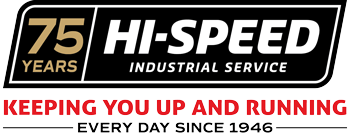If you rely on electric motors for your business, who do you call for maintenance or repair services? While a quick internet search will provide you with a list of nearby shops that will claim they can handle your electric motor issues, how do you know that the repairs will be done correctly and in a timely fashion? The answer is to select an EASA-accredited shop, like Hi-Speed Industrial Service.
EASA is an acronym for the Electrical Apparatus Service Association, which “provides engineering consulting services to members and works with manufacturers, industry organizations, and government agencies to promote better repair standards and assure the highest quality professional service for customers.” The EASA comprises over 1,900 member shops in nearly 70 countries worldwide. Of this membership, only 138 shops have met all the required criteria to receive their EASA accreditation for servicing electric motors and rotating equipment, such as generators, pumps, and compressors.
The EASA Accreditation Process
To achieve EASA Accreditation, service centers undergo independent third-party evaluation to ensure they use prescribed good practices to maintain motor efficiency and reliability during electrical and mechanical repairs of electric motors.
The EASA has developed a checklist, based on ANSI/EASA AR-100: Recommended Practice for the Repair of Rotating Electrical Apparatus and The Good Practice Guide to Maintain Motor Efficiency, which can be downloaded from the EASA website.
EASA-approved auditors then inspect your workspaces and processes across 23 areas, including:
| Housekeeping | Employee Training | Internal Audits |
| ID/Condition Assessment | Accessories | Cooling System |
| Shafts | Bearings (Ball/Roller/Sleeve) | Lubrication |
| High-Potential Tests | Squirrel Cage Rotors | Balancing |
| Bearing Insulation | Winding Impregnation | Rewind Data |
| Stator Windings, Insulation, Conductors, and Coils | Terminal Leads, Connectors, and Boxes | Winding Insulation & Coil Tests |
| Frame & Bearing Housings | Winding Removal & Core Integrity
|
No-Load Tests |
| Finish & Handling | Calibration |
EASA accreditation also requires that the auditor verify that specific tools are on-site and properly calibrated, including.
Electrical Tools
| Milli-ohmmeter | Ohmmeter | AC Voltmeter |
| AC Ammeter | AC Wattmeter | Megohmmeter |
| Hi-Potential Tester | Surge Tester | Core Tester/Loop Test |
| Growler (functional) | Test Panel |
Mechanical Tools
| Inside Micrometer | Outside Micrometer |
| Dial Indicators | Digital Tachometer |
| Terminal Crimpers | Vibration meter |
| Balancing Machine | Gauge Blocks (if applicable) |
Physical Tools
| Temperature Meters |
| Burnout oven part temperature control |
| Burnout oven, analog or digital recorder |
| Burnout oven water-mist system (Verification by the service center) |
| Bake oven temperature control |
| Winding machine with turn counter (Verification by the service center) |
| VPI system vacuum gauge (VPI outsourcing is permissible) |
| VPI system pressure gauge (VPI outsourcing is permissible) |
EASA Exclusions
The following types of motors and machines have specific requirements, certifications, and inspection processes, and are not covered by the EASA accreditation process.
- Explosion-proof components
- Dust-ignition-proof components
- Hazardous locations
- Hermetic motors
- Hydrogen-cooled machines
- Submersible motors
- Traction motors
- Class 1E nuclear service motors
The EASA Accreditation period starts from the date of a successful inspection and audit. To ensure that companies use the latest maintenance and repair techniques, the accreditation process must be renewed every 3 years.
EASA Accreditation Benefits for Customers
When an electric motor requires maintenance or repairs, why would you trust your business’s bottom line to just any service center?
Customers who choose an EASA-accredited repair shop, such as Hi-Speed, can be confident that their motors and components will be maintained or repaired to the highest standards, thereby improving efficiency and reliability.
Thanks to standardized inspection and repair procedures, customers can expect the same level of quality and workmanship, no matter which service technician is assigned to them.
The EASA Accreditation makes it easy for customers to connect with shops committed to following industry-best practices to deliver superior service while reducing future unexpected downtime.
EASA Accreditation Benefits for Service Centers
Independent third-party audits validate that the shop consistently follows industry standards and best practices when servicing your electric motors. It’s important to remember that only 1% of EASA member shops hold this accreditation.
Following a consistent set of rules and best practices improves worker efficiency and morale while reducing the potential for errors and repetitive repairs. Accredited shops typically have better employee retention and performance evaluations than other service centers.
Unexpected repairs are expensive and seem to always happen at the worst possible time. However, the EASA Accreditation provides you with peace of mind, knowing that
the best talent in the industry will have them up and running again, as quickly as possible.
Should you have any questions about our EASA Accreditation or other electric motor topics, such as parts, preventive maintenance plans, or back-up motor storage
The Hi-Speed team can be reached 24 hours a day at 1-800-713-0103 and via email.
Additional Electric Motor Resources
Based on your interest in repairing an electric motor, here are some recent blog posts you might find interesting or helpful.
Best Electric Motor Repair Practices
The Essential Guide to Getting Your Electric Motors Serviced or Repaired

